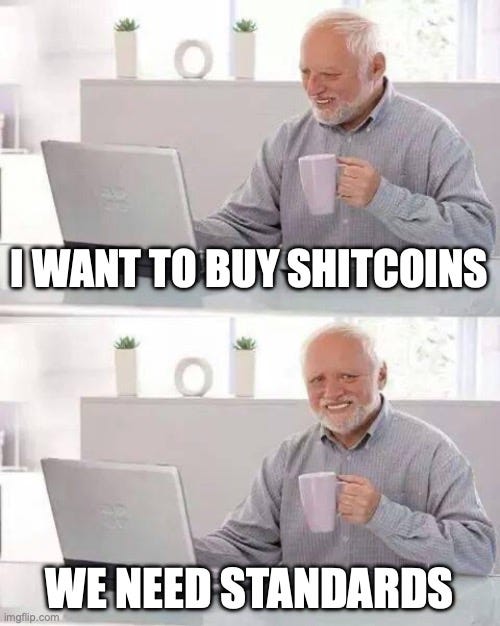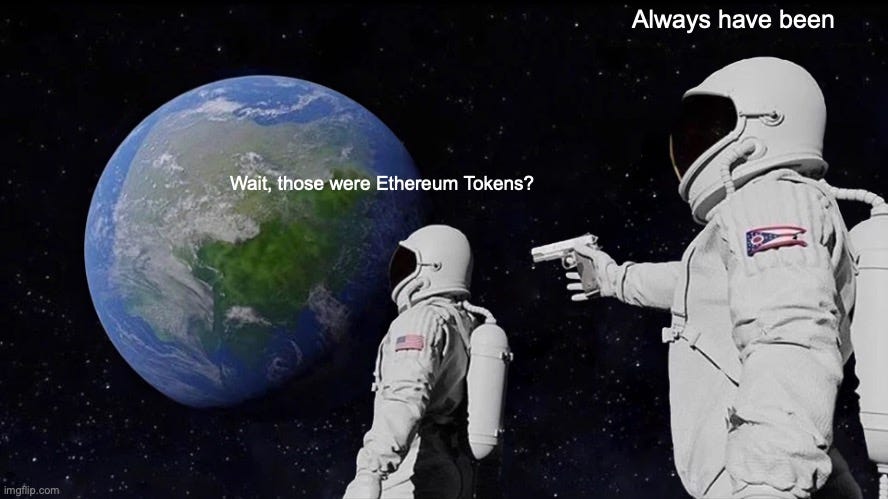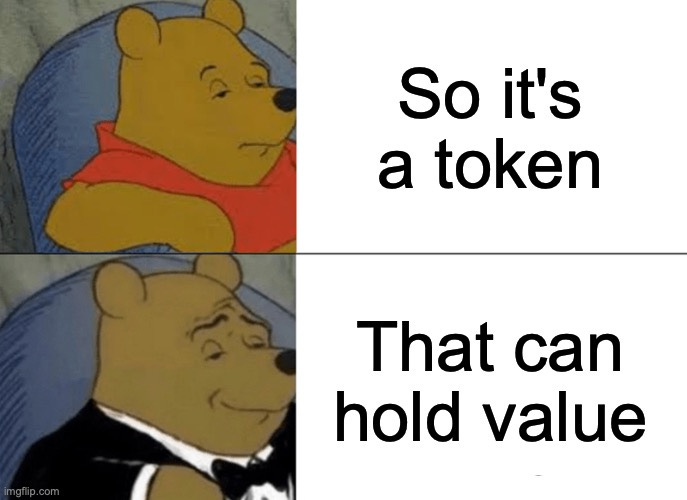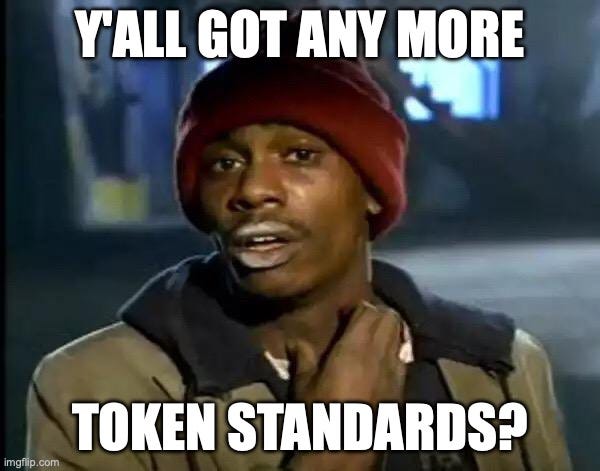Token standards allow us to trade tokens on DEX’s and NFT marketplaces, creating the permissionless space we all love. How were these standards developed, and what does each do? Today’s write-up goes through the three main ones, and some extra ones for fun. Enjoy.
*Thank you to Lianna and Ziad for proofreading.
ERC-20: Fungible Tokens
The first token standard on Ethereum was ERC-20, implemented in 2015. Back then, tokens already existed on Ethereum; people had already realized they could use smart contracts to create them. These tokens behaved the same, each token from a smart contract was the same as any other that came from it, so they’re “fungible.”
The problem was that each token contract was different. They did things differently, and even where they did the same things, they called those functions by different names.
The ERC-20 standard did exactly that- it standardized the basics of what a token is and what it should be able to do. The original definition outlined two main features: that tokens should be transferrable from one address to another, and that a function should be able to determine how many tokens are in a particular wallet. It also defines some additional (but optional) features tokens could choose to implement.
Following the adoption of the standard in late 2015, in 2016 Ethereum saw massive growth in the number of tokens created on the network, leading to a record setting year in funding for ICOs (Initial Coin Offerings). DAOs also leveraged the standard, using tokens to represent voting potential.
ERC-721: Non-Fungible Tokens
By this time, NFTs already “existed.” The first NFT is believed to be Quantum, minted on the Namecoin blockchain in 2014. Rare Pepes were being sold on Counterparty in 2016, a Bitcoin platform, but were still a novelty that most were unaware of. While 2016 was the year of ICOs, 2017 was the year of NFTs.
CryptoPunks launched in June 2017 and CryptoKitties followed in November, with quite a few others throughout the year. Each Punk and Kitty was an NFT, but the ERC-721 standard did not exist yet. To make their tokens distinguishable, the companies behind these projects had to develop their own solutions. The interest these projects saw encouraged the development of a standard.
The ERC-721 standard was pioneered by Dapper Labs, the creators of CryptoKitties. The purpose for NFTs was to represent ownership of specific assets, virtual or physical. Distinguishable tokens are necessary for this, since each piece of art, or house, or car, is distinct from each other (i.e. non-fungible).
ERC-1155: Multi-Class Tokens
2018 saw the release of the ERC-1155 standard (example here). The idea was to bridge the gap between ERC-20 and ERC-721, so that there could be many editions of a digital item or piece of art. Without this, every item in a game would need to come from a different smart contract. This is an important analogy, as development on ERC-1155 was led by Enjin and Horizon, companies making products for game and metaverse companies.
With ERC-1155, each item could be an NFT with as many editions as necessary. Each edition of that NFT is the same as any other; they’re as fungible as ERC-20 tokens are. At the same time, every NFT and its editions is distinct and separate from each other NFT in the collection.
Additional Token Standards
It is surprising to note that there are actually at least 36 token standards, the proposals for which are in various stages of the EIP approval process (read more about that here). Here are some cool ones:
ERC-3525: Semi-Fungible Tokens
ERC-3525 tokens are enhanced versions of ERC-721 NFTs with an additional property. Specifically, they can hold value. This makes this type of token excellent for financial instruments like bonds or retirement accounts, since the value they hold is a property available on the blockchain, not through NFT metadata off-chain.
ERC-4519: Non-Fungible Tokens Tied to Physical Assets
ERC-4519 tokens are also enhanced ERC-721 tokens that are tied to individual internet connected devices (IoT) and allows them to perform actions on the blockchain. Each device can have an NFT associated, allowing a user to control that device securely using the blockchain.
ERC-5484: Consensual Soulbound Tokens
ERC-5484 tokens are enhanced ERC-721 tokens that cannot be transferred from the wallet that they are sent to. However, they can be “burned” or removed by either the sender or recipient. These tokens will be excellent uses for identification, membership, and other such use cases.
To Conclude
Token standards are the criteria for different types of tokens. Tokens today can represent unique assets, exchangeable ones, or even physical devices. This allows applications to use the type most suitable for them. As Ethereum grows, the future will likely see an even greater diversity of tokens, making each even more practical.
Thank You & Additional Reading!
Thank you for reading! Here are some more resources if you'd like to dive deeper.
2016: The Year Blockchain ICOs Disrupted Venture Capital by Sid Kalla and Matt Chwierut
NFT Timeline: The Beginnings and History of NFTs by Jolene Creighton
Here Be Dragons: Going Beyond ERC-20 and ERC-721 To Reduce Gas Cost by ~80% by Phillippe Castonguay
Sign up if you haven’t already for more simple write-ups on blockchain concepts!
Share a Summary
Thanks again, please consider sharing this write-up below!
Stay kind. Stay curious.








